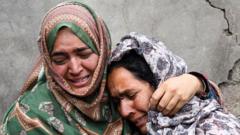

The India-Pakistan border, a region fraught with historical tensions and geopolitical complexities, remains one of the world's most dangerous. This assessment stems from a combination of factors, including the unresolved territorial disputes, cross-border terrorism, nuclear capabilities of both nations, and a history of armed conflicts. The most recent escalation, triggered by a deadly militant attack in Pahalgam, Indian-administered Kashmir, serves as a stark reminder of the volatile nature of this border.
The roots of the India-Pakistan conflict lie in the 1947 partition of British India, which created a Muslim-majority Pakistan and a Hindu-majority India. The partition led to widespread displacement and violence, leaving a legacy of mistrust and animosity that continues to shape relations between the two countries. The princely state of Jammu and Kashmir, with its diverse population and strategic location, became a major point of contention. The Maharaja of Kashmir initially sought independence but eventually acceded to India in exchange for military assistance against invading Pakistani tribesmen, sparking the first Indo-Pakistani War in 1947-48.
Since then, India and Pakistan have fought several wars and engaged in numerous skirmishes, primarily over Kashmir. The Line of Control (LoC), established by the 1972 Simla Agreement, divides Kashmir into two administrative regions, but it has not resolved the underlying territorial dispute. Cross-border terrorism has further exacerbated tensions, with India accusing Pakistan of supporting militant groups operating in Kashmir. Pakistan denies these charges, but the issue remains a major obstacle to improved relations.
The recent attack in Pahalgam, which killed 26 people, mostly tourists, led to a sharp escalation between India and Pakistan. India launched "Operation Sindoor," a military strike targeting alleged terrorist infrastructure in Pakistan and Pakistan-administered Kashmir. Pakistan condemned the strikes and vowed to retaliate. Both sides engaged in gunfire across the LoC, and tensions soared, raising fears of a wider military conflict.
In the aftermath of the Pahalgam attack, India announced a series of retaliatory measures against Pakistan, including suspending the Indus Waters Treaty, halting most visas, and stopping all trade. Pakistan responded with its own set of actions, including the suspension of visas for Indians, a trade ban, and the closure of its airspace to Indian flights. The Attari-Wagah border crossing, the only land route between the two countries, was also shut down, causing emotional scenes as families were separated.
On May 10, 2025, India and Pakistan reached an understanding to halt all military actions across land, air, and sea. However, the ceasefire remains fragile, and questions remain about the long-term prospects for peace. The underlying issues, including the Kashmir dispute and cross-border terrorism, have not been resolved, and mistrust continues to run deep.
The India-Pakistan border is not only dangerous due to the risk of military conflict but also because of the humanitarian consequences for the people living in the region. Cross-border shelling and infiltration attempts have resulted in civilian casualties, displacement, and a constant state of fear. The closure of border crossings disrupts trade, economic activity, and people-to-people contact, further isolating the region.
The international community has repeatedly called for de-escalation and dialogue between India and Pakistan. The United States and China have urged both sides to exercise restraint and avoid actions that could further complicate the situation. However, finding a lasting solution to the India-Pakistan conflict remains a daunting challenge, requiring a sustained commitment to peace, dialogue, and addressing the root causes of the dispute.
In conclusion, the India-Pakistan border remains one of the world's most dangerous due to a complex interplay of historical, political, and security factors. The recent escalation has underscored the fragility of peace in the region and the urgent need for a comprehensive approach to address the underlying issues and promote lasting stability.